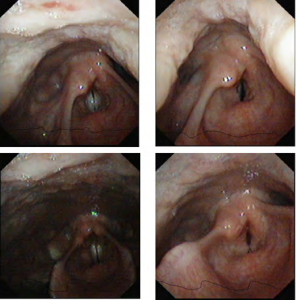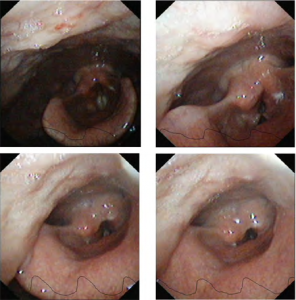Cincinnati, Ohio, USA
Proceedings of the 10th International Conference on Advances in Quantitative Laryngology, Voice and Speech Research June 3-4, 2013, Cincinnati, Ohio, USA
VOCAL EFFECTS IN SINGING: A STUDY OF INTENTIONAL DISTORTION USING LARYNGOSTROBOSCOPY AND ELECTROLARYNGOGRAPHY
Julian A McGlashan1, Mark Sayles1, Cathrine Sadolin2
1Department of Otorhinolaryngology, QMC Campus, Nottingham University Hospitals Nottingham NG7 2UH, UK 2 Complete Vocal Institute, Hausergade 3-5, 1128 Copenhagen, Denmark
Keywords: Singing Voice; Vocal effect; Intentional Distortion; Electrolaryngography; Laryngostroboscopy
INTRODUCTION
Intentional Distortion (ID) is a sound commonly used in rock and other commercial genres of music which adds a grating noise to a sung note for vocal effect [1]. In contrast unintentional distortion is an uncontrolled, unintentional noise which is a result of faulty technique. A good commercial example of this effect can be heard on the word ‘down’ from the line “Don’t dream of women ’cause they only bring you down” sung by Dio [2]. There is debate as to whether this voice quality is damaging to the voice and vocal folds but the reality is that this vocal effect is widely used by some singers without causing apparent harm [1].
Previous studies have demonstrated that ID is produced by vibration of the false folds [3,4,5,6]. Borch [6] with digital high-speed imaging and McGlashan et al [3,4] showed with synchronized electro-laryngography (ELG) and stroboscopy and that during periods of ID vocal fold vibration appears to continue relatively unimpeded.
Sadolin has developed a pedagogic method named the Complete Vocal Technique for teaching singing [1]. The concept, determined from experiential development, is that there are four main modes of singing (Neutral, Curbing, Overdrive and Edge) which vary in the degree of ‘metal’ added to the sound. Each mode is associated with ‘rules and limitations’ in production which aid the singer in producing sounds of different pitch, loudness and vocal quality. Each can also be modulated in terms of sound quality (dark and light). Once the mode and sound color can be controlled vocal effects, including ID, can be added. The main objectives of this study were (1) to further elucidate the mechanism of production of ID during singing and (2) to examine the affect of ID on vocal fold vibration on a sustained vowel in each of the four modes by assessing changes in ELG and acoustic parameters.
METHODS
Singers
Twenty singers (10 male, 10 female) with a median age of 34 (range: 20-52) took part in the study. They had a median of 13.5 (range: 2-26) years experience in teaching
Cincinnati Children’s Hospital Medical Center and the University of Cincinnati
singing and a median of 4.6 (range 1-15) years experience in CVT. Their main style of singing included pop (9), rock (3), classical (2), soul (2), jazz, rhythmical, experimental and gospel (1each).
Instrumentation
In study (1) each singer was examined using an OTVS7 camera (Olympus) and ENFV2 videoscope (Keymed) coupled to the Laryngostrobe (Laryngograph) digital capture system. Laryngograph electrodes were positioned over the thyroid cartilages and an omnidirectional microphone placed at distance from the singer which allowed recordings at all levels of loudness. In study (2) the ELG and acoustic signals were captured and analysed with the Speech Studio (Laryngograph) software program.
Study (1)
Each singer was asked to sing a sustained note at a comfortable pitch, sound color and mode alternating at least twice between the mode and mode with ID. Two assessors (JM & CS) rated the laryngopharyngeal changes by consensus.
Study (2)
Each singer was asked to sing a sustained note at a comfortable pitch, sound color and mode alternating at least twice between the mode and mode with ID across all four modes. The mean fundamental frequency (Fx) and standard deviation of Fx (SD Fx), mean (Qx) and standard deviation of the Contact Quotient (SD Qx), Jitter Factor, Shimmer +, Normalized Noise Energy (NNE) and Sound Pressure Level (SPL dB) were extracted from an average of 470ms of sustained vowel using the multidimensional voice profile (MDVP) analysis in the Speech Studio (Laryngograph) program.
RESULTS AND DISCUSSION
Study (1)
Sixteen (8 male, 8 female) video recordings were of adequate quality for analysis. The key changes in the laryngopharyngeal appearances with ID are summarized in Table 1 and are demonstrated for each mode in Fig. 1(a-b, c-d).
81
Proceedings of the 10th International Conference on Advances in Quantitative Laryngology, Voice and Speech Research June 3-4, 2013, Cincinnati, Ohio, USA
Table 1. Number of features present in the n=16 singers
[6] Borch DZ et al. Vocal fold vibration and source aperiodicity in ‘dist’ tones: a study of a timbral ornament in rock singing Logoped Phoniatr 2004;29(4):147-153.
Figure 1. Images on left (i) are the mode without ID and on the right (ii) with ID for a male singer:
| During Intentional Distortion: | Yes |
| False folds vibrate | 15 |
| Medial-lateral constriction false folds | 15 |
| Anterior-posterior constriction false folds | 14 |
| Larynx raises | 14 |
| Posterior-lateral pharyngeal wall constriction | 13 |
| Narrowing of piriform fossae | 13 |
| Epiglottis drawn backwards | 12 |
| Arytenoid complex drawn anteriorly | 9 |
| Posterior pharyngeal wall drawn forwards | 1 |
a)Neutral and b) Curbing. a)i
a)ii
Study (2)
Twenty singers were able to produce adequate pairs of sound samples for analysis in almost every mode with and without ID. The results of 3-way ANOVA with the factors sex, mode, and distortion for each of the MDVP parameters are shown in Table 2.
Table2. Three-way ANOVA for factors sex, mode and ID for ELG (1) and acoustic (2) parameters
ID is associated with a significantly higher degree SD Fx (16.2 vs 6.2; p<0.05) and SD Qx (9.6 vs 4.9; p<0.05) but not mean Fx or mean Qx (p>0.05). Jitter Factor (p<0.05), Shimmer+ (27.9 vs 11.3; p<0.05), NNE (-2.4 vs -18.7; p<0.05) and mean SPL (92.6 vs 91.2dB; p<0.05) These differences may be secondary to the largely aperiodic false cord vibration.
REFERENCES
[1]Sadolin C. Complete Vocal Technique. 3rd ed. Copenhagen, Denmark: CVI Publications; 2012.
[2] “Don’t talk to strangers” sung by Dio
http://www.youtube.com/watch?v=c-CHAAInf_ks
[3] http://www.youtube.com/watch?v=nJu_BQrfk3E [4] http://www.youtube.com/watch?v=fqqXYR07WgE [5] Titze IR. Deliberate use of distortion in singing. J
Acoust Soc Am 1998;103(5):2796-2797.
Cincinnati Children’s Hospital Medical Center and the University of Cincinnati
b)i
b)ii
| Sex | Mode | ID | |
| Mean FX1 | <0.0001 | 0.28 | 0.23 |
| SD FX1 | <0.0001 | 0.006 | <0.0001 |
| Mean QX1 | <0.0001 | <0.0001 | 0.92 |
| SD QX1 | <0.0001 | 0.25 | <0.0001 |
| Jitter Factor1 | <0.0001 | 0.005 | <0.0001 |
| Shimmer+2 | 0.59 | 0.0002 | <0.0001 |
| NNE2 | 0.66 | 0.0025 | <0.0001 |
| Mean SPL2 | 0.53 | <0.0001 | 0.032 |
c) Overdrive and d) Edge. c)i
c)ii
Written by Julian McGlashan



